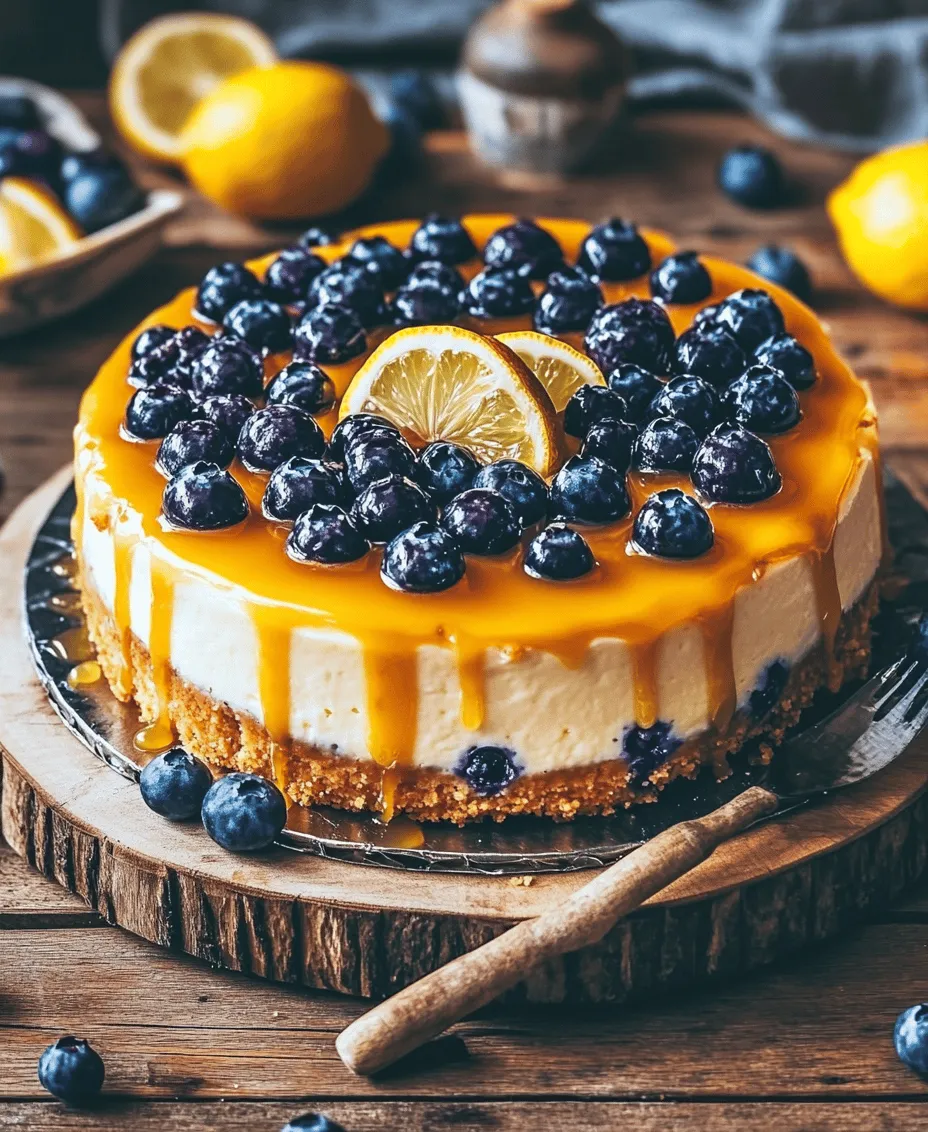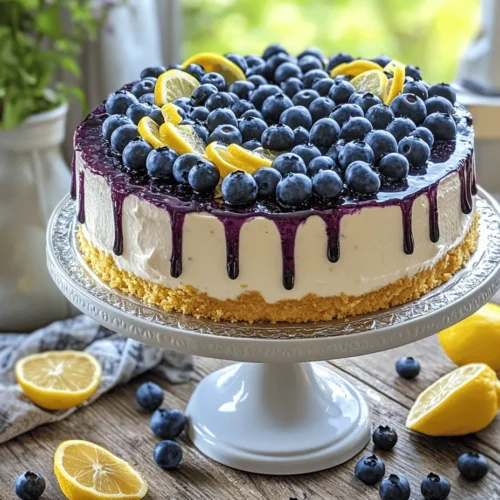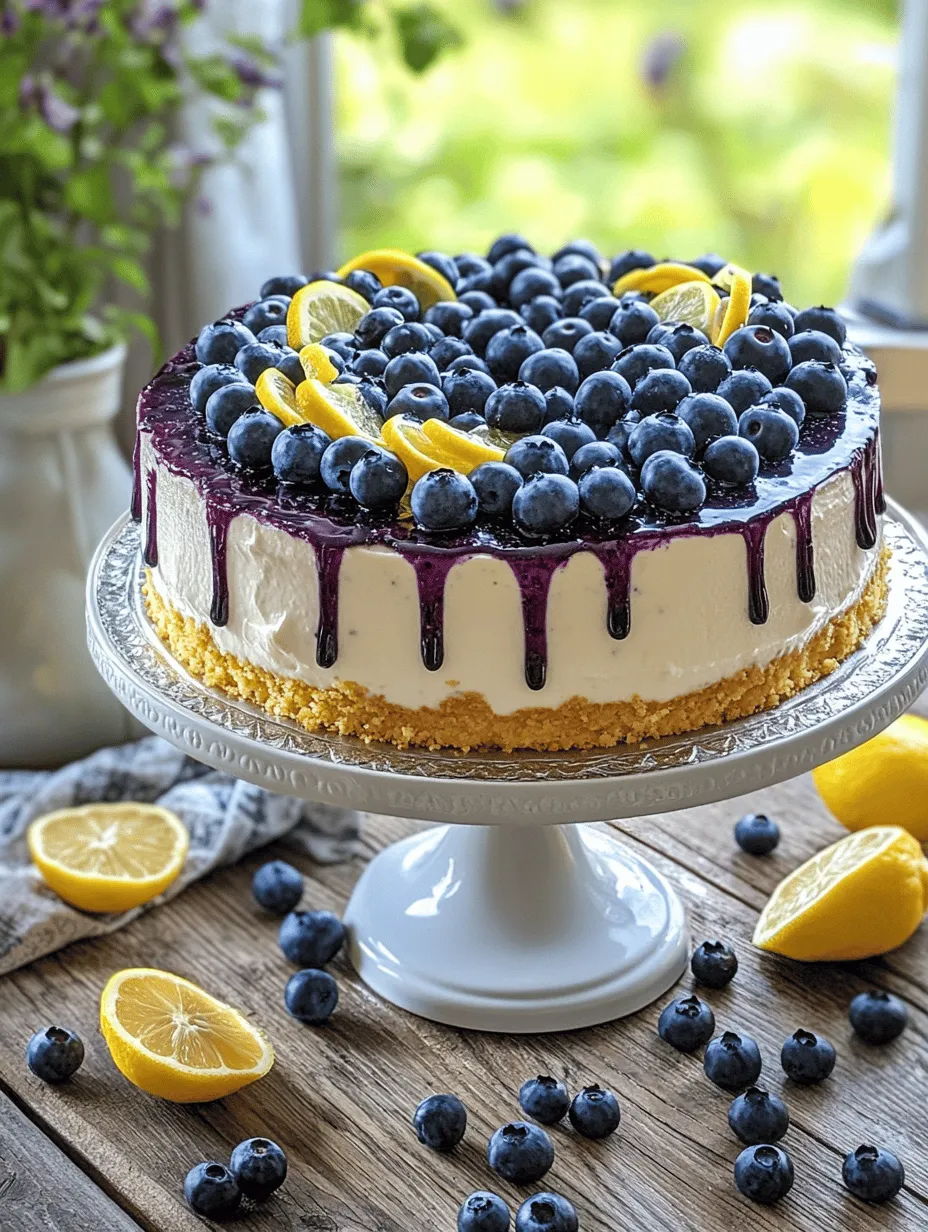Introduction
If you’re in search of a dessert that perfectly marries flavor and visual appeal, the Lemon Blueberry Cheesecake Cake is a standout choice that will elevate any occasion. This delightful fusion of zesty lemon and sweet blueberries creates a symphony of tastes that is both refreshing and indulgent. As you slice into this layered cake, you will discover a luscious cheesecake layer nestled between fluffy cake layers, culminating in a dessert that is as rich as it is light.
The origin of this cake is rooted in the classic cheesecake, which has been enjoyed for centuries, with variations emerging from different cultures around the world. The addition of lemon and blueberries adds a modern twist, enhancing the traditional flavors while introducing a vibrant color palette. This cake is not just a treat for the taste buds, but also a feast for the eyes, making it ideal for gatherings, parties, or simply as a special indulgence after a long day.
In this article, we will walk you through the intricacies of this delightful recipe, breaking down the essential ingredients, their roles, and providing you with step-by-step instructions to ensure your baking experience is seamless. Whether you’re a seasoned baker or a novice in the kitchen, this recipe is approachable and rewarding. Let’s dive into the essential components that make the Lemon Blueberry Cheesecake Cake a must-try dessert.
Understanding the Ingredients
Exploring the Elements of the Cake
Every great cake starts with a solid foundation, and the Lemon Blueberry Cheesecake Cake is no exception. Understanding the role of each ingredient not only enhances your baking skills but also equips you with the knowledge to make adjustments if necessary.
– All-Purpose Flour: This versatile flour serves as the backbone of your cake, providing the necessary structure and stability. It absorbs moisture and helps the cake hold its shape while rising.
– Baking Powder and Baking Soda: These essential leavening agents work in tandem to create a light and airy cake. Baking powder contains both an acid and a base, allowing it to produce carbon dioxide when mixed with liquid and heated. Baking soda, on the other hand, requires an acid (like buttermilk or lemon juice) to activate its leavening properties.
– Unsalted Butter: The richness of unsalted butter adds moisture and flavor to the cake. Using unsalted butter allows you to control the salt levels in your recipe, ensuring a perfectly balanced cake.
– Granulated Sugar and Powdered Sugar: Granulated sugar sweetens the cake while also contributing to its texture. Powdered sugar, used in the glaze, helps create a smooth, sweet finish that beautifully complements the tangy flavors of lemon.
– Eggs: Eggs are crucial for binding the ingredients together, adding moisture, and providing structure. They also help to leaven the cake, giving it that sought-after rise.
– Buttermilk: The tangy flavor of buttermilk not only enhances the taste of the cake but also tenderizes it. The acidity of buttermilk interacts with the baking soda, contributing to the leavening process.
– Fresh Blueberries: These little bursts of flavor add sweetness and moisture to the cake. Using fresh blueberries ensures that you get the best flavor and texture in each bite.
– Lemon Zest and Juice: The zest and juice of lemons are pivotal in infusing the cake with bright acidity and freshness. The zest contains essential oils that deliver a concentrated lemon flavor, while the juice adds moisture and further enhances the tanginess.
The Cheesecake Layer Breakdown
A defining feature of this cake is its rich cheesecake layer, which adds a creamy texture and depth of flavor.
– Cream Cheese: The star of the cheesecake layer, cream cheese provides a smooth, creamy base that is essential for achieving the desired texture. Choosing full-fat cream cheese will yield the best results.
– Additional Sugar: A bit of sugar balances the tanginess of the cream cheese, ensuring a harmonious flavor profile.
– Eggs and Vanilla: Just like in the cake, eggs help to bind the cheesecake layer together while adding richness. Vanilla extract enhances the overall flavor, complementing the lemon and blueberry.
– Lemon Juice and Zest: Similar to the cake layers, lemon juice and zest brighten the cheesecake filling, adding a refreshing note that cuts through the richness of the cream cheese.
The Lemon Glaze Composition
To finish off this stunning dessert, a lemon glaze is drizzled on top, providing a sweet and tangy contrast.
– Powdered Sugar: This fine sugar creates a smooth texture for the glaze, allowing it to drizzle beautifully over the cake.
– Lemon Juice: Using fresh lemon juice in the glaze offers a tartness that balances the sweetness of the powdered sugar, creating a refreshing finish to each slice.
Step-by-Step Preparation
Prepping the Kitchen
Before diving into the recipe, it’s important to prepare your kitchen for an efficient baking experience. Gather all necessary tools and equipment to streamline the process.
– Essential Tools and Equipment: You will need mixing bowls for combining ingredients, an electric mixer for achieving a smooth batter and cheesecake filling, measuring cups and spoons for accuracy, a rubber spatula for scraping down the sides of bowls, and a baking pan to hold your cake layers. Additionally, having parchment paper on hand for lining the baking pan can help ensure easy removal of the cake once baked.
– Setting the Oven: Preheating the oven is a crucial step that should not be overlooked. A preheated oven ensures that your cake begins baking at the correct temperature, allowing it to rise properly and develop the desired texture. Set your oven to 350°F (175°C) and allow it to fully preheat while you prepare the batter.
Crafting the Cheesecake Layer
Creating the cheesecake layer is perhaps the most critical step in achieving the creamy texture and rich flavor that defines this dessert. Follow these best practices for mixing and combining your ingredients effectively.
1. Mix the Cream Cheese: In a mixing bowl, begin by beating the cream cheese until it’s soft and creamy. This step is essential for avoiding lumps in your cheesecake filling.
2. Add Sugar: Gradually add the additional sugar to the cream cheese, continuing to beat until the mixture is smooth and well combined.
3. Incorporate Eggs: Add the eggs one at a time, mixing well after each addition. This gradual incorporation helps to maintain the smooth texture of the cheesecake filling.
4. Flavor Enhancements: Finally, mix in the vanilla extract, lemon juice, and lemon zest. This is where you’ll achieve that delightful tanginess that complements the sweetness of the blueberries.
5. Final Mixing: Ensure all ingredients are fully combined and the mixture is smooth. Scrape down the sides of the bowl to incorporate any clinging bits of cream cheese or sugar.
By following these steps, you’ll create a rich and creamy cheesecake layer that melds beautifully with the fluffy lemon blueberry cake. In the next part of this article, we will explore the preparation of the cake layers and the assembly process, ensuring that your Lemon Blueberry Cheesecake Cake is a show-stopping dessert that is sure to impress. Stay tuned for the continuation of this delightful culinary journey!

Flavor Enhancements
When crafting your Lemon Blueberry Cheesecake Cake, you have the wonderful opportunity to customize the lemon flavor to your liking. If you prefer a more pronounced lemon taste, consider adding extra lemon zest or a tablespoon of fresh lemon juice into the batter. For a subtle hint, reduce the quantity slightly or use Meyer lemons, which are sweeter and less acidic than regular lemons. Additionally, incorporating lemon extract can enhance the lemony aroma without adding more moisture, maintaining the cake’s structure. Remember, the key is to balance the tartness of the lemon with the sweetness of the blueberries and the creaminess of the cheesecake layer, creating a harmonious flavor profile.
Creating the Cake Batter
Creaming Butter and Sugar
The first step in creating the cake batter is the creaming of butter and sugar, a crucial process that influences the cake’s texture. Start by ensuring your butter is at room temperature; this allows it to incorporate air when mixed with sugar, resulting in a light and fluffy batter. Using an electric mixer, beat the butter and sugar on medium speed until the mixture turns pale and fluffy, typically about 3-5 minutes. This step not only adds volume but also helps create a tender crumb in the finished cake. The science behind this is simple: the air pockets created during creaming expand during baking, leading to a lighter texture.
Incorporating Dry and Wet Ingredients
Once your butter and sugar are perfectly creamed, it’s time to incorporate the dry and wet ingredients. Begin by sifting together your flour, baking powder, and salt in a separate bowl. This ensures that the baking powder is evenly distributed and helps prevent clumps. Next, alternate adding the dry mixture and your wet ingredients (like sour cream and milk) to the creamed butter mixture. Start with the dry ingredients, followed by the wet, and repeat this process. Mixing just until combined is essential; overmixing can lead to a dense cake due to gluten development. The goal is a smooth batter that retains some airiness from the creaming process.
Layering the Cake
Tips for Even Layering
When it comes to layering your cake and cheesecake for baking, evenness is key for both aesthetics and baking consistency. Start by dividing your cake batter between the prepared cake pans. You can use a kitchen scale to ensure each layer has the same weight, which translates to even baking. For the cheesecake layer, pour the cheesecake batter gently over the cake batter, using a spatula to spread it evenly. If you’re concerned about the layers mixing, use a spoon to create a slight well in the center of the cake batter before adding the cheesecake mixture.
Understanding Cake Structure
Layering not only affects the visual appeal but also the cake’s structure. The denser cheesecake layer will naturally sink a little into the lighter cake mix, creating a beautiful marbled effect. During baking, the structure of the cheesecake will help support the cake layers, preventing them from collapsing. This unique layering technique is what gives the Lemon Blueberry Cheesecake Cake its signature look and texture, ensuring that each slice is a delightful combination of cake and cheesecake.
Baking and Cooling
Optimal Baking Times
Baking the Lemon Blueberry Cheesecake Cake requires careful attention to timing. Generally, bake your cake at 325°F (163°C) for 30-35 minutes. To determine if your cake is perfectly baked, insert a toothpick into the center of the cake; it should come out clean or with a few moist crumbs. Remember that ovens can vary, so keep an eye on your cake as it nears the end of the suggested baking time to avoid overbaking, which can lead to a dry texture.
Cooling Techniques
Once baked, it’s essential to cool the cake properly. Allow the cake to cool in the pans for about 10-15 minutes before transferring it to a wire rack. Cooling in the pans helps maintain moisture and flavor development, while transferring it to a wire rack allows air to circulate, preventing sogginess. Moreover, letting the cake cool completely before frosting is crucial; if the cake is still warm, the frosting can melt, affecting both the appearance and taste.
Crafting the Lemon Glaze
Achieving the Perfect Consistency
Creating a lemon glaze to drizzle over your cake adds an extra layer of flavor and brightness. To achieve the perfect consistency, combine powdered sugar with freshly squeezed lemon juice. Start with a cup of powdered sugar and gradually add lemon juice until you reach your desired thickness. If the glaze is too thick, add more lemon juice; if it’s too thin, incorporate more powdered sugar. A well-balanced glaze should be pourable yet thick enough to hold its shape when drizzled.
Flavor Balancing
Balancing sweetness and tartness in your glaze is key to enhancing the cake’s overall flavor. If the glaze turns out too sweet, a splash of lemon juice can help cut through the sweetness, creating a more complex flavor profile. Conversely, if the glaze is too tart, adding a bit more powdered sugar can round out the flavors, ensuring that the glaze complements the cake without overpowering it.
Serving Suggestions
Presentation Ideas
When it comes to serving your Lemon Blueberry Cheesecake Cake, presentation is everything. Start by placing the cake on a decorative cake stand or a large platter. To elegantly present the cake, consider using a serrated knife to slice clean edges, revealing the beautiful layers inside. You can dust the top with a light sprinkle of powdered sugar for an elegant finish.
Garnishing
Garnishing your cake enhances its visual appeal and adds a fresh touch. Consider decorating the top with fresh blueberries, perhaps arranging them in a circular pattern around the cake’s edge. Thin slices of lemon can also be added, either on the top or around the base of the cake. Edible flowers or mint leaves can introduce a pop of color, making the cake visually stunning and inviting.
Pairing Recommendations
Beverage Pairings
To elevate the experience of enjoying your Lemon Blueberry Cheesecake Cake, consider pairing it with refreshing beverages. A chilled glass of lemonade or iced tea complements the citrus notes of the cake beautifully. For a more decadent option, serve it with a light sparkling wine or champagne, which can cut through the richness of the cheesecake layer and cleanse the palate.
Dessert Pairings
If you’re planning a dessert spread, consider serving the Lemon Blueberry Cheesecake Cake alongside other light desserts. A scoop of vanilla bean ice cream or a dollop of whipped cream can provide a creamy contrast to the cake’s textures. Fresh fruit, such as strawberries or raspberries, can also be a delightful addition, enhancing the fruity flavors of the cake while adding a vibrant color contrast.
Nutritional Information
Caloric Breakdown
Understanding the nutritional profile of your Lemon Blueberry Cheesecake Cake can help you enjoy it mindfully. Each slice contains a blend of ingredients that contribute to its caloric content. The primary ingredients include cream cheese, butter, sugar, and flour, all of which play a role in the overall nutrition. A typical slice may range from 350-450 calories, depending on portion size and specific ingredient variations. If you are interested in a more detailed breakdown, consider using a nutrition calculator to input your specific ingredients.
Dietary Considerations
For those with dietary restrictions, this cake can be modified to fit various needs. To make a gluten-free version, simply substitute the all-purpose flour with a gluten-free flour blend. For a reduced-sugar option, you can replace some of the sugar with natural sweeteners like honey or maple syrup, although this may alter the texture slightly. Additionally, for a dairy-free version, consider using plant-based cream cheese and butter alternatives.
Conclusion
The Lemon Blueberry Cheesecake Cake is more than just a dessert; it’s a celebration of flavors and textures that brings joy to any occasion. With its layers of cake and cheesecake, complemented by a zesty lemon glaze, this recipe offers a delightful balance of sweetness and tang. As you prepare this cake, you’ll not only enjoy the process but also create a stunning centerpiece that is sure to impress your family and friends. Embrace the experience of baking and savor the delicious results that await you. Whether you are celebrating a special occasion or simply indulging in a sweet treat, this cake promises to be a delightful addition to your dessert repertoire.



